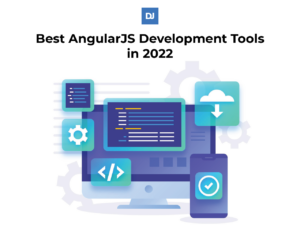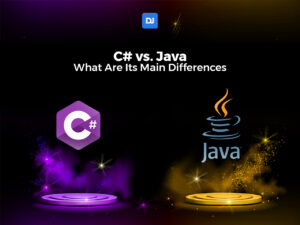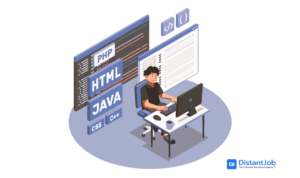One of the most common dilemmas for businesses is choosing between building an app compatible with iOS or Android. Some companies prefer choosing one of the two platforms while others decide to develop an application that runs in both.
But the real battle is about choosing the best framework to develop a cross-platform mobile application: Xamarin vs. Flutter 2022. These are some of the most popular cross-platform app frameworks of 2022.
On the wide web, the opinions are mixed. Xamarin is considered to be the most mature, if slower between the two, while Flutter is praised for its speed, but criticized for its (as of yet) limited framework. But is that really all there is to it?
Let’s get into it and compare the two to make the decision of which to pick for your projects easier for you.
Xamarin and Flutter: A Brief Overview
Cross-platform app development frameworks are the golden key for companies to create their business apps.The magic of these frameworks is that mobile developers can create applications compatible with more than one operating system.
Xamarin and Flutter are part of these relatively new cross-platform app development frameworks (also often called Hybrid App frameworks). These allow teams to develop an app for several mobile platforms simultaneously by sharing the majority of the code between them and developing the UI separately for the native feel. The project is then compiled to the native code of the target platform and thus can pass as a native app, enjoying increased performance and access to its distinguishing features.
While both Xamarin and Flutter have the same end goal and even share similarities, they each have their own strengths and preferred use cases.
Xamarin
Xamarin is a framework that helps in the development of cross-platform mobile applications. This open-source platform was founded in 2011, but Microsoft purchased it in 2016.
Xamarin cross-platform development mainly targets three mobile platforms: Android, iOS, and Windows. It provides the option to reuse and share code between these platforms while providing access to native APIs. Developers can build mobile apps that look and feel entirely native.
This framework is one of the most used among developers due to all its advantages.
Xamarin examples of apps include Storyo, MRW, and the game Transistor.
Flutter
Flutter is an open-source mobile UI framework created by Google and released in 2017. This framework allows developers to create a native mobile application with only one codebase. Developers can use one programming language and the same codebase to create apps that work on different operating systems.
Flutter has two important aspects:
- A Software Development Kit (SDK): It’s a collection of tools that help developers build applications. (tools that help transform code into native machine code)
- A Framework (UI Library): It’s a collection of reusable UI elements that help developers personalize their needs for the app.
Flutter examples of apps include Reflectly, eBay Motors, and Google Stadia.
Xamarin vs Flutter Comparison: Main Features
Hybrid App frameworks usually involve a number of common features to allow developers to streamline and speed up cross-platform development. Let’s go over these features and see what each has to offer.
1. Programming Language
Flutter uses Dart as its programming language, while the Xamarin language of choice is C#.
In terms of use and adoption, C# has by far the larger community. C# has more expert developers since it has had more years to establish itself, but also because it is used in conjunction with the powerful and widespread .NET Framework.
Dart, on the other hand, is a more recently developed language and hasn’t seen much adoption besides Flutter itself, so it’s harder to find developers for it.
2. Technical Architecture
Xamarin’s architecture uses:
- Mono: an open-source implementation of Microsoft’s .NET Framework (also compatible with it).
- Runtime: Android (Android), Objective-C (iOS).
- Kernel: Linux (Android), UNIX-like (iOS).
Flutter’s architecture uses:
- Flutter framework: written in Dart and includes the main components of an app, such as widgets and Material libraries.
- Flutter engine: written in C++ and implements graphics through the Skia graphics library.
- Embedder: the gateway to the appropriate operating system for the platform, written in that platform’s native code.
3. Performance and App Size
Both frameworks boast performance that is very close to native. To compare Xamarin vs Flutter in terms of performance is harder to establish, since we’d need two identical applications (each developed in a framework) to provide a meaningful metric. Easier said than done.
In the same vein, app size increases are unavoidable since these frameworks need libraries to port over the framework code to native. Compared to native, these apps will always have some extra size to make up for this fact.
4. Pricing and IDE Support
Flutter is free to use and can be developed in many IDEs, the most popular right now being Visual Studio Code.
Xamarin is also free to use (in principle). Development of Xamarin Apps is usually done in Visual Studio (not to be confused with Visual Studio Code), which provides various tools and features to help with said development. There is a free version, but paid subscriptions of Visual Studio will provide more tools (and arguably more useful, like an inspector and profiler). Depending on its size, a company developing an app can find itself in a situation where it is forced to buy a subscription for its developers.
5. Installation
Xamarin will usually require Visual Studio to be installed in order to install. The Xamarin SDK can be obtained and set up in the Tools menu as an extension package.
As for Flutter, you must download the SDK zip file, extract its contents, and then add the folder to the PATH variable of your operative system.
Now that we know where these two frameworks differ let’s go over the main advantages and establish where they are best used.
Xamarin vs Flutter Comparison: Pros and Cons
Having the whole panorama of both frameworks will help mobile app devs to decide which one to use.
Businesses can also determine what type of developer to hire: A Xamarin-oriented developer or a Flutter-oriented developer.
Let’s take an overview of each framework’s respective pros and cons.
Xamarin Pros
1. Performance
Xamarin is popular mainly because it offers developers features that make the app run as if it was native. This means that Xamarin developers can build Android and iOS applications despite their entirely different operating systems.
2. Scalability
Another characteristic that makes Xamarin applications have excellent performance is that developers can test how the application is running. With Xamarin Insights, it’s easy to detect if an app has any bugs or errors. It offers a real-time app monitoring feature to ensure everything in the app is running efficiently.
3. Xamarin.Forms
Xamarin.Forms are a huge advantage for developers. It’s a cross-platform UI toolkit that makes the job easier for a developer who wants to create shared UI layouts. Some of them even choose to use this framework rather than Xamarin Native for many reasons. For instance, with Xamarin. Forms developers don’t need to learn all the native UI frameworks and can design views quicker.
4. Supports libraries
Imagine having a deadline for tomorrow about a topic you have no idea about. What is the first thing that comes into your mind? Google! Think about these libraries as you think of Google: the solution to everything. And Xamarin gains another golden star because of its ability to use a variety of libraries. Xamarin lets developers implement the most complicated functionality without pouring sweat (or tears).
Xamarin Cons
1. Knowledge of native languages
If you are a developer, you should know that using Xamarin requires that you know the fundamental aspects of the operating systems you are trying to develop the app for. Although you don’t need to be an expert, you should know the programming languages used in the systems. For example, if you want to build a cross-platform app for Android and iOS, you need to have a basic knowledge of Java and Kotlin (Android), and also Swift and Objective-C (iOS).
2. Large App Size
This depends on the type of application you are trying to build. But overall, Xamarin apps are larger than native ones. The size may range from 5MB to 20MB.
3. Not suitable for complex applications
Xamarin is efficient when it comes to building apps with a simple UI. However, when developers have to create an application with complex animations, or heavy graphics, Xamarin might not be the best option because it consumes a lot of the developers time because they have to write many specific codes.
4. Smaller community
The Xamarin community is smaller than the native iOS and Android communities. This means that finding an experienced Xamarin developer can be challenging, especially if you have a hard time headhunting talented developers.
Also, because the community is smaller. Some developers might have a hard time learning and finding support whenever they are facing problems. Yet, the platform provides extensive support, and it even has an educational platform: Xamarin University.
Flutter Pros
1. Fast Development
Flutter is one of the fastest cross-platform frameworks. It allows developers to use the same code base and build separate iOS and Android apps. This means that the application’s development process is speedy, and development teams don’t need to waste time working on the code for a single platform.
2. Great for startups
Flutter is a great tool to use for your minimum viable product. It’s cheaper to develop mobile apps because, as stated previously, one code developer can create and maintain an application in different operating systems. Plus, you don’t need to hire a team of IT experts to build your app, with one skilled developer who understands Flutter is more than enough to create your MVP.
3. Hot Reload feature
This feature makes it possible to make changes to the code and see the results (live) in the app preview. It also helps developers experiment, build UIs, add features and fix errors.
4. Beautiful design
Two powerful characteristics of Flutter are the excellent programming language (Dart) and a fast-performance rendering engine (Skia). This makes the platform help developers create applications with design patterns and best practices. Flutter provides beautiful and customizable widgets making the developers build apps that look great!
Flutter Cons
1. It’s still an immature framework
Flutter is still new, which means that it still has a few errors regarding its stability. Some users also claim that there’s a lack of advanced features that support operating systems capabilities.
2. Managing new system features
Whenever iOS or Android introduces new features to their operating systems, these will reflect later in Flutter than in their native software development kits.
3. Limited libraries
Flutter receives Google’s constant support, and many libraries help developers whenever they need to implement specific functionalities. However, because Flutter is still a new framework, not every function is available in these libraries. Ultimately, if a developer needs a specific functionality, they will need to build them by themselves.
4. Large file size
One of the major disadvantages is the large size that the apps developed with Flutter have. When apps take up a lot of memory space in a mobile, users tend to be more selective. And although there are phones that have enough capacity to store the app, this is not the case for all of them. Older devices, or even new ones, sometimes don’t have much space, and users have to decide if it’s worth deleting an app to download the new one.
Main Differences Between Xamarin and Flutter
Are you still struggling to try to figure out which platform is the best one for developing your upcoming app?
Let’s recap what we’ve established as the main differences between Xamarin and Flutter:
| Xamarin | Flutter | |
| Released | 2011 | 2017 |
| Programming language | C# | Dart |
| Code reusability | 96% | 80% |
| Pricing | Open-source For commercial use between $500 and $3000. | Open-source |
| IDEs support | * Visual Studio * XCode | * Android Studio * Visual Studio Code * IntelliJ DEA |
| Performance | Close to native | Close to native |
| UI components | Native UI components | Built-in customize UI components |
| Graphic/animations | Poor | Moderate |
| Technical architecture | Mono | Skia |
| App size | Large | Large |
| Portability | iOS, Android, Windows, Mac OS | iOS, Android |
Which One to Choose? Xamarin or Flutter?
What is the verdict? Which one of these frameworks is the best one for cross-platform mobile applications?
The answer is…both! Both are excellent for developing applications!
It depends on your priorities and the aspects you consider your application should have or how it should perform. In general terms, Flutter is more popular than Xamarin. A vast number of developers instead use Flutter because of its features and because although it’s still new, it keeps improving. But if you prioritize the aspects that Xamarin is stronger at, Xamarin is your option to go.
Our advice is to look at the characteristics you prioritize more and see which of both frameworks covers those priorities. Then you could get into looking for a developer who can build the application for you.
If you have no idea how to start looking for talented techies, contact us! We are happy to help you scale your team with the best remote Xamarin Developer or Flutter developer.




